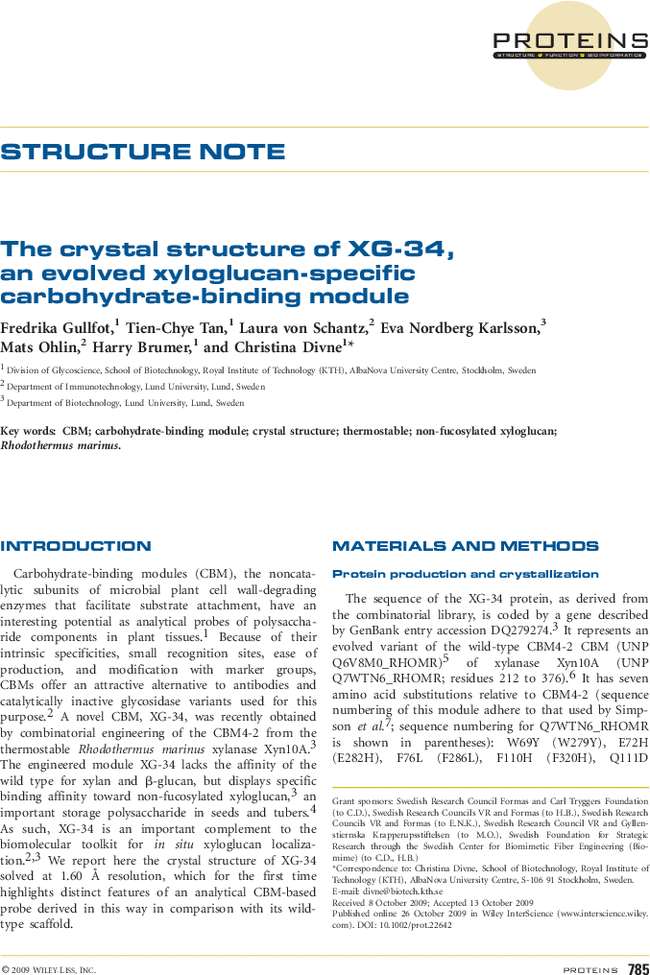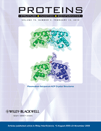The crystal structure of XG-34, an evolved xyloglucan-specific carbohydrate-binding module
Fredrika Gullfot
Division of Glycoscience, School of Biotechnology, Royal Institute of Technology (KTH), AlbaNova University Centre, Stockholm, Sweden
Search for more papers by this authorTien-Chye Tan
Division of Glycoscience, School of Biotechnology, Royal Institute of Technology (KTH), AlbaNova University Centre, Stockholm, Sweden
Search for more papers by this authorLaura von Schantz
Department of Immunotechnology, Lund University, Lund, Sweden
Search for more papers by this authorEva Nordberg Karlsson
Department of Biotechnology, Lund University, Lund, Sweden
Search for more papers by this authorMats Ohlin
Department of Immunotechnology, Lund University, Lund, Sweden
Search for more papers by this authorHarry Brumer
Division of Glycoscience, School of Biotechnology, Royal Institute of Technology (KTH), AlbaNova University Centre, Stockholm, Sweden
Search for more papers by this authorCorresponding Author
Christina Divne
Division of Glycoscience, School of Biotechnology, Royal Institute of Technology (KTH), AlbaNova University Centre, Stockholm, Sweden
School of Biotechnology, Royal Institute of Technology (KTH), AlbaNova University Centre, S-106 91 Stockholm, Sweden===Search for more papers by this authorFredrika Gullfot
Division of Glycoscience, School of Biotechnology, Royal Institute of Technology (KTH), AlbaNova University Centre, Stockholm, Sweden
Search for more papers by this authorTien-Chye Tan
Division of Glycoscience, School of Biotechnology, Royal Institute of Technology (KTH), AlbaNova University Centre, Stockholm, Sweden
Search for more papers by this authorLaura von Schantz
Department of Immunotechnology, Lund University, Lund, Sweden
Search for more papers by this authorEva Nordberg Karlsson
Department of Biotechnology, Lund University, Lund, Sweden
Search for more papers by this authorMats Ohlin
Department of Immunotechnology, Lund University, Lund, Sweden
Search for more papers by this authorHarry Brumer
Division of Glycoscience, School of Biotechnology, Royal Institute of Technology (KTH), AlbaNova University Centre, Stockholm, Sweden
Search for more papers by this authorCorresponding Author
Christina Divne
Division of Glycoscience, School of Biotechnology, Royal Institute of Technology (KTH), AlbaNova University Centre, Stockholm, Sweden
School of Biotechnology, Royal Institute of Technology (KTH), AlbaNova University Centre, S-106 91 Stockholm, Sweden===Search for more papers by this author
REFERENCES
- 1 Knox JP. Revealing the structural and functional diversity of plant cell walls. Curr Opin Plant Biol 2008; 11: 308–313.
- 2 McCartney L,Gilbert HJ,Bolam DN,Boraston AB,Knox JP. Glycoside hydrolase carbohydrate-binding modules as molecular probes for the analysis of plant cell wall polymers. Anal Biochem 2004; 326: 49–54.
- 3 Gunnarsson LC,Zhou Q,Montanier C,Karlsson EN,Brumer H,III,Ohlin M. Engineered xyloglucan specificity in a carbohydrate-binding module. Glycobiology 2006; 16: 1171–1180.
- 4 Carpita N,McCann M. The cell wall. In: B Buchanan, W Gruissem, R Jones, editors. Biochemistry and molecular biology of plants. Rockville, MD: American Society of Plant Physiologists; 2000. pp 52–108.
- 5 Gunnarsson LC,Karlsson EN,Albrekt AS,Andersson M,Holst O,Ohlin M. A carbohydrate binding module as a diversity-carrying scaffold. Protein Eng Des Sel 2004; 17: 213–221.
- 6 Karlsson EN,BartonekRoxa E,Holst O. Cloning and sequence of a thermostable multidomain xylanase from the bacterium Rhodothermus marinus. Biochim Biophys Acta 1997; 1353: 118–124.
- 7 Simpson PJ,Jamieson SJ,Abou-Hachem M,Karlsson EN,Gilbert HJ,Holst O,Williamson MP. The solution structure of the CBM4-2 carbohydrate binding module from a thermostable Rhodothermus marinus xylanase. Biochemistry 2002; 41: 5712–5719.
- 8 Abou-Hachem M,Olsson F,Karlsson EN. Probing the stability of the modular family 10 xylanase from Rhodothermus marinus. Extremophiles 2003; 7: 483–491.
- 9 Kabsch W. Automatic processing of rotation diffraction data from crystals of initially unknown symmetry and cell constants. J Appl Crystallogr 1993; 26: 795–800.
- 10 McCoy AJ,Grosse-Kunstleve RW,Adams PD,Winn MD,Storoni LC,Read RJ. Phaser crystallographic software. J Appl Crystallogr 2007; 40: 658–674.
- 11 Perrakis A,Morris R,Lamzin VS. Automated protein model building combined with iterative structure refinement. Nat Struct Biol 1999; 6: 458–463.
- 12 Cohen SX,Morris RJ,Fernandez FJ,Ben Jelloul M,Kakaris M,Parthasarathy V,Lamzin VS,Kleywegt GJ,Perrakis A. Towards complete validated models in the next generation of ARP/wARP. Acta Crystallogr D Biol Crystallogr 2004; 60: 2222–2229.
- 13 Murshudov GN,Vagin AA,Dodson EJ. Refinement of macromolecular structures by the maximum-likelihood method. Acta Crystallogr D Biol Crystallogr 1997; 53: 240–255.
- 14 Collaborative Computational Project, Number 4. The CCP4 suite: programs for protein crystallography. Acta Crystallogr D Biol Crystallogr 1994; 50: 760–763.
- 15 Painter J,Merritt EA. Optimal description of a protein structure in terms of multiple groups undergoing TLS motion. Acta Crystallogr D Biol Crystallogr 2006; 62: 439–450.
- 16 Jones TA,Zou JY,Cowan SW,Kjeldgaard M. Improved methods for building protein models in electron density maps and the location of errors in these models. Acta Crystallogr A 1991; 47: 110–119.
- 17 Emsley P,Cowtan K. Coot: model-building tools for molecular graphics. Acta Crystallogr D Biol Crystallogr 2004; 60: 2126–2132.
- 18 DeLano WL. The PyMOL molecular graphics system. Palo Alto, CA: DeLano Scientific; 2002.
- 19 Keitel T,Simon O,Borriss R,Heinemann U. Molecular and active-site structure of a Bacillus 1,3-1,4-beta-glucanase. Proc Natl Acad Sci U S A 1993; 90: 5287–5291.
- 20 Divne C,Stahlberg J,Reinikainen T,Ruohonen L,Pettersson G,Knowles JKC,Teeri TT,Jones TA. The three-dimensional structure of the catalytic core of cellobiohydrolase I from Trichoderma reesei. Science 1994; 265: 524–528.
- 21 Kleywegt GJ,Zou JY,Divne C,Davies GJ,Sinning I,Stahlberg J,Reinikainen T,Srisodsuk M,Teeri TT,Jones TA. The crystal structure of the catalytic core domain of endoglucanase I from Trichoderma reesei at 3.6 angstrom resolution, and a comparison with related enzymes. J Mol Biol 1997; 272: 383–397.
- 22 Boraston AB,Nurizzo D,Notenboom V,Ducros V,Rose DR,Kilburn DG,Davies GJ. Differential oligosaccharide recognition by evolutionarily-related beta-1,4 and beta-1,3 glucan-binding modules. J Mol Biol 2002; 319: 1143–1156.
- 23 Bae B,Ohene-Adjei S,Kocherginskaya S,Mackie RI,Spies MA,Cann IKO,Nair SK. Molecular basis for the selectivity and specificity of ligand recognition by the family 16 carbohydrate-binding modules from Thermoanaerobacterium polysaccharolyticum ManA. J Biol Chem 2008; 283: 12415–12425.
- 24 Notenboom V,Boraston AB,Chiu P,Freelove ACJ,Kilburn DG,Rose DR. Recognition of cello-oligosaccharides by a family 17 carbohydrate-binding module: an X-ray crystallographic, thermodynamic and mutagenic study. J Mol Biol 2001; 314: 797–806.
- 25 Charnock SJ,Bolam DN,Turkenburg JP,Gilbert HJ,Ferreira LMA,Davies GJ,Fontes C. The X6 “thermostabilizing” domains of xylanases are carbohydrate-binding modules: Structure and biochemistry of the Clostridium thermocellum X6b domain. Biochemistry 2000; 39: 5013–5021.
- 26 Boraston AB,Revett TJ,Boraston CM,Nurizzo D,Davies GJ. Structural and thermodynamic dissection of specific mannan recognition by a carbohydrate binding module, TmCBM27. Structure 2003; 11: 665–675.
- 27 Gunnarsson LC,Montanier C,Tunnicliffe RB,Williamson MR,Gilbert HJ,Karlsson EN,Ohlin M. Novel xylan-binding properties of an engineered family 4 carbohydrate-binding module. Biochem J 2007; 406: 209–214.
- 28 Abou-Hachem M,Karlsson EN,Simpson PJ,Linse S,Sellers P,Williamson MP,Jamieson SJ,Gilbert HJ,Bolam DN,Holst O. Calcium binding and thermostability of carbohydrate binding module CBM4-2 of Xyn10A from Rhodothermus marinus. Biochemistry 2002; 41: 5720–5729.
- 29 Lovell SC,Davis IW,Adrendall WB,de Bakker PIW,Word JM,Prisant MG,Richardson JS,Richardson DC. Structure validation by C alpha geometry: phi, psi and C beta deviation. Proteins 2003; 50: 437–450.




